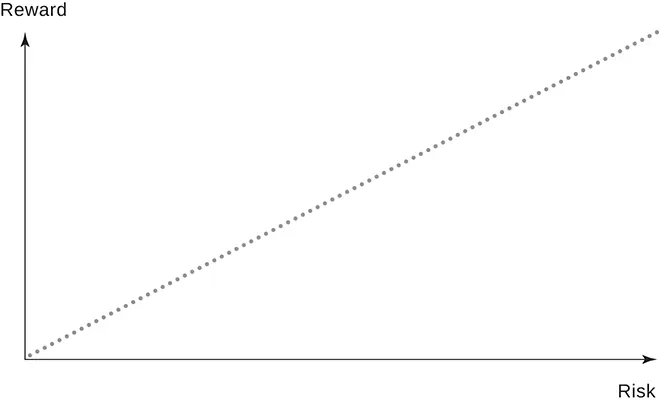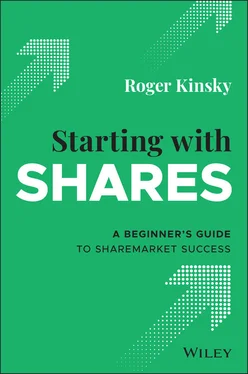Throwing darts at a share listing pinned to a board isn't really practical, but choosing a mix of shares by random selection is certainly possible. Choosing shares by random selection is still known as a dart or dartboard approach.
Some time ago I tried each of these two strategies to see the result. I chose a mix of 10 shares based on my research and I chose another mix using a selection process based on random numbers. I wrote down the shares each strategy had indicated and their current price. Some time later I checked the share prices and worked out the profit or loss each strategy had produced.
Guess what? Each strategy resulted in a profitable investment and, in fact, the dart approach was slightly superior to the careful selection approach!
When I pointed this out in a share investing course, one student responded with a simple question: ‘If that's so, why am I wasting my time and money doing this course?’
I admit this question floored me for a while and I couldn't really think of a reasonable answer. As I pondered on it, I came to realise a fundamental truth about share investing that this question had highlighted. Despite what most people think, choosing shares in the first place is really not the most important consideration for successful share investing. What really matters is what you do with the shares after you've bought them — that is, your management plan. I'll expand on management plans in chapter 11but for now I'd like you to remember that you need a management plan if you're going to be a successful share investor.
My experiment also showed that although the dart approach is based on random selection, it can result in a good mix of shares because it's likely to give you a varied selection of many different types of shares. Having a varied mix of different types of shares is known as diversification , and is a strategy I'll expand on in later chapters. The real benefit of a dart approach is that it overcomes personal prejudice. We all have in‐built preferences based on a combination of hereditary and environmental factors that we often aren't even aware of and which affect our decisions and actions. With share selection, they're likely to bias our selection process in one way or another. For example, you may have had your fingers burnt in the past with certain shares or certain types of shares and so may now have a ‘once bitten, twice shy’ bias toward these shares.
The main takeaway here is that it's important to build a selection of diversified shares and it's even more important to manage them successfully.
I expand on psychological factors relevant to share investing in later chapters.
Risk and reward are related
A really important principle of investing is that risk and reward are related. Reward with investing is the amount of profit you're likely to make. In most cases, as the potential reward increases, so too does the risk. Figure 1.1 shows shows the hypothetical relationship between risk and reward.

Figure 1.1: Increasing your possible reward usually means increased risk
The ‘safer’ an investment, the less risk is involved and so the less profit you can expect. I'm sure you already have a fundamental understanding of this relationship and that is why you want to get into shares. You realise that share investing involves more risk than a comparatively safe investment such as a bank deposit but the compensation for taking the higher risk is that the rewards can be greater. You also understand that you need to take the higher risk to reap the reward of a higher potential profit.
Shareholders are owners of a business
When you become a shareholder you're investing in a business. In fact, you become a part owner of that business. So what's a business? A business is a commercial enterprise that provides a product or service to consumers and usually aims to make a profit. (A non‐profit‐making business can be set up for charitable purposes but this is rare for Australian companies with listed shares.) You can't be a shareholder in businesses such as partnerships and private (or proprietary) companies unless invited to do so by the directors. The most common type of business in which you can be a shareholder is the public company.
As you might guess, a public company is a type of business where anyone can become a part‐owner. It follows that the company has no control over who the owners are. Larger companies are also known as corporations .
The company has a separate legal identity from the owners and is regarded as a separate entity at law. This is known as a body corporate and means that the company can act very much as a person can in business situations. For example, the company owns assets and has liabilities (debts). It can enter into contracts such as contracts for employment or for the purchase of goods or services. Because of the separate legal identity, the assets of the owners are immune from the assets of the company.
So if you're a shareholder in a company, no matter how much financial difficulty the company may get itself into, your personal assets can't be used to pay creditors or to help bail the company out. In extreme cases, you could lose the money you've invested in their shares but that's the limit of your liability. A public company often uses the abbreviation ‘Ltd’ at the end of the name to indicate the limited liability of the owners.
BHP (Broken Hill Proprietary) is a well‐known Australian public company with issued shares. The term proprietary is normally used to indicate a private company (that is, belonging to a proprietor or proprietors), as in ‘Pty Ltd’. When BHP changed from a private to a public company, it obtained special exemption to retain ‘proprietary’ in the name because ‘BHP’ was so widely recognised by Australians.
I assume you don't have a good knowledge of shares and need to start from square one.
With share investment strategies, it's generally better to err on the side of simplicity rather than complexity and keep in mind that simple strategies often work as well as complex ones.
You don't have to know a heap about shares for them to be a profitable investment for you.
The sharemarket has an inherent element of unpredictability associated with it.
No share investing strategy works in every situation and there's certainly no magic bullet.
Risk and reward are closely related; if you want a higher profit, you need to accept that a higher risk will be involved.
Most companies aim to make a profit from the sale of a product or service.
While many types of legal business structures are possible in Australia, the main structure applicable to shares is the limited company. If the shares are listed on an exchange, they can be purchased by anyone so this type of company is also known as a public company.
Chapter 2 Getting into shares
In this chapter, I discuss some of the basics about investing in shares, starting with some common terms you're likely to encounter. I then look at the different ways you can come to own shares and so become a share investor, and consider shares you can invest in as well as those you can't. I also explain why share prices change and the most commonly quoted prices. This will set the groundwork so you have a good foundation to work from as you get more into shares.
Читать дальше













